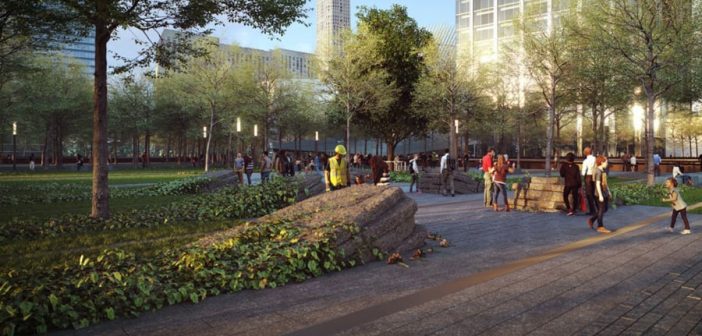The original design had a serious oversight: It didn’t pay homage to the first responders and rescue workers who survived 9/11. Now, the designers are trying to amend it.
It’s a cold day in February, and I’m walking through the 9/11 Memorial Plaza in downtown Manhattan. I approach the Survivor Tree, which was found in the wreckage after the 2001 terrorist attack on the World Trade Center and nursed back to health before being installed as part of the memorial in 2010. Directly to my right, the plaza’s southwest corner is fenced off, with a bulldozer sitting next to bags of dirt.
Come May, this construction site will be a new memorial–a corrective for a group of people overlooked in the original 9/11 memorial design by architect Michael Arad. That design–two reflecting pools buried in the ground like shadows of the original towers–commemorates the names of the nearly 3,000 people who died in the attack itself. But more than 1,000 first responders, rescue workers, and local residents have died since, because of the toxins released in the collapse of the towers, and it’s likely that hundreds of thousands of people overall were exposed. According to Alice Greenwald, president and CEO of the National September 11 Memorial & Museum, the new memorial is designed to commemorate those losses–and the continued suffering of the tens of thousands who are now ill from 9/11-related illnesses.
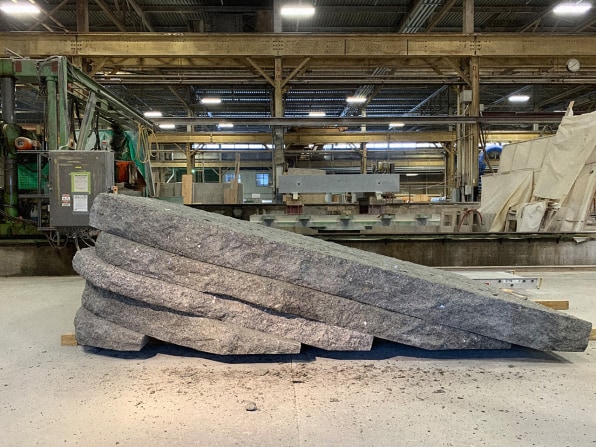
THE DESIGN INTENT
Many first responders and locals who were suffering from these illnesses, as well as the families whose loved ones had died after the attack, felt the existing memorial overlooked this important group of victims. After gathering input from the victims and their families, Arad and landscape architect Peter Walker designed an addition to the plazato amend the original design’s oversight. Arad chose an already existing glade of trees near the Survivor Tree and envisioned transforming the area with a path that cuts through the trees, framed by six boulders erupting out of the ground. The 9/11 Memorial & Museum released renderings of the design (seen up top) in the summer of 2018.
“I [was]trying to find a way to convey strength and resilience but also the difficulty of that experience, the toll that it took. But even bruised and battered, [the boulders]remain standing,” Arad says. “They remain forceful in their resistance. It’s really drawing on the character of the people who came here, trying to find a way to represent that spirit that brought people to the site, that kept them at the site through many months through difficulties and horrors and many injuries.”
The pathway will align with the ramp that the first responders used to haul debris away from the site. (That ramp also doubled as an ad hoc memorial, where people left flowers and paid respects before the memorial plaza was built.) Perhaps most symbolically, the boulders will have grooves carved into them, which will then be inset with steel from the World Trade Center towers, mimicking the ancient Japanese art of kintsugi, where artisans fill in pottery cracks with resin and gold dust. “This idea that we may be broken by the weight of the sadness and the disaster that we’ve lived through and now people are suffering–but we’re also stronger at the broken places, and the steel is an element of strength,” Greenwald says. “It’s true of the resilience of this city.”
The design was developed with and vetted by former rescue workers and first responders, first responder advocates, representatives from the medical community who have worked with 9/11-related diseases, family members of victims, government representatives, and Lower Manhattan residents.
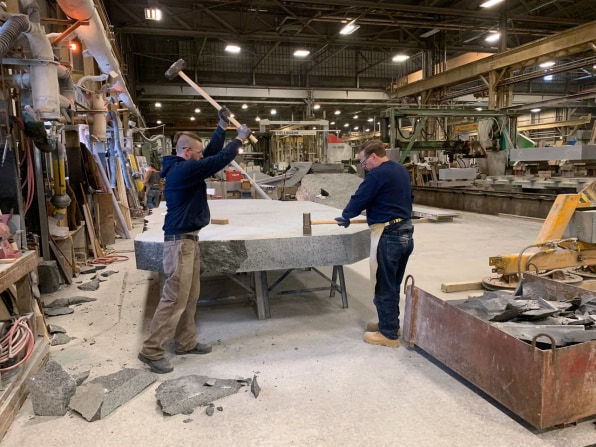
FROM SCHOOL BUS-SIZED CHUNK TO ARAD’S BOULDERS
With just three months left to go before the memorial opens, fabricators are rushing to finish the job. Arad tapped a granite manufacturing company called Rock of Ages to fabricate the stones and transform Laurentian Green granite that was quarried in Canada into the majestic, worn boulders he envisions. The largest slabs are 12 feet by 8 feet in size, and can be anywhere from 7 to 13 inches thick. Arad compared the granite pieces to slices of “a loaf of bread the size of a small school bus.” The slabs of granite will be stacked on top of each other in a sloping fashion so that they look like they’re bursting out of the earth.
Now, the artisans at Rock of Ages are chiseling the stone by hand to create a weathered look. The process, which Rock of Ages created specifically for this memorial, requires stonecutters to use a diamond-edge saw to make random diagonal cuts across the surface of the top-most stone and the edges of the others. Then, the cuts are hand-chiseled to smooth out the edges. This creates an uneven, natural effect, helping to achieve Arad’s vision of roughly hewn, worn boulders that would convey the resilience of the first responders and rescue workers.
Finally, the stone is “thermalled,” a process in which the artisans use something similar to a blowtorch to heat up the rock until it “pops” and the top layers of the rock start to come off. The technique is used to finish the rock so that you can’t see any evidence of the sawing or chiseling–almost like a burning hot eraser. It’s akin to sanding, where you get sawdust-like debris, except in this case, it’s actually grains of stone. According to Dave Fournier, a stonework veteran at Rock of Ages with 35 years experience, the new 9/11 memorial is signficantly different from other memorials, from a fabrication perspective, because it requires a rough, not a smooth, finish. For Arad, a natural look is a key element of the design; thermalling was crucial for removing any trace of the stonecutter’s hand.
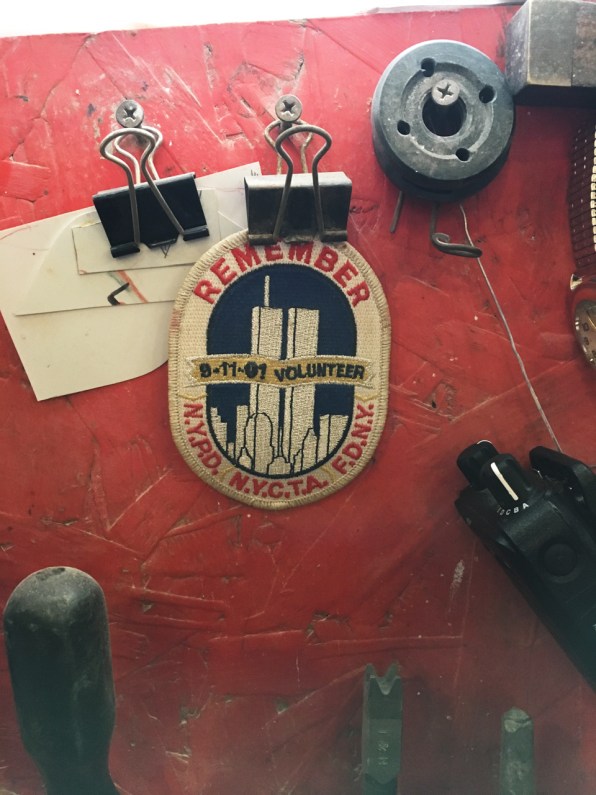
Interestingly, some of those working on the granite are local first responders themselves. Stone carver Andy Hebert, who also works as the second assistant chief of the Plainfield Fire Department in Vermont, says he’s been honored to work on the memorial. He keeps a patch at his work bench to remind him of the people who died on 9/11, and he even has a tattoo on his arm with “9-11” in the middle to commemorate the tragedy.As the stoneworkers continue to work on the granite leading up to the dedication day on May 30, artistic fabrication company KC Fabrications, which created the bronze name parapets for the original memorial, has been preparing the steel from the World Trade Center to embed into the boulders. Chris Powers, who founded KC Fabrications, says that the 9/11 Memorial Foundation gave him a catalog of debris from the collapsed towers that are stored in a warehouse upstate. He chose small pieces of steel that would be easy to work with, and his team visited Rock of Ages’s factory in Vermont to create wax molds of the cracks the stoneworkers carved into the granite. These molds will then be cast using the steel from the towers. It will be installed in the boulders once they’re moved to the plaza.
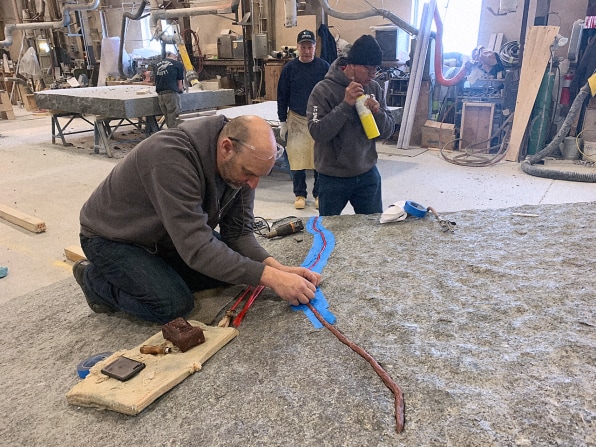
A NEW “CENTER OF GRAVITY”
What will it be like to experience this new memorial? If you’re approaching from the southwestern side of the plaza, the path will be a serene entry point into the larger memorial. The path will cut through a grassy glade, with the same swamp white oak trees that cover the rest of the plaza guarding its periphery. If you look up, you’ll be able to see 1 World Trade Center, presiding over the plaza like another kind of memorial–one to the necessity of moving forward. As you walk, the immense granite boulders with the inlaid steel will rise out of the earth, reaching perhaps to your waist. The Survivor Tree will wait on the other side.
Ultimately, Arad wants the new glade to have its own “center of gravity,” as he called it, so that it complements the existing pools but doesn’t overshadow them. “When the design was selected and built, we weren’t attuned to this need that would unfold over time,” he says. “It was an oversight, and I’m grateful we have the opportunity to correct it because it’s very much needed.”
For Greenwald, the completed memorial is a way to remind people of the ongoing impact of 9/11, and help them remember this crucial part of the story: the bravery and generosity of the first responders and rescue workers. “My hope is that when the glade is completed it will feel so integral to the memorial space,” she says. “It’s going to look like it was always there, like it was meant to be there.”
–
This article first appeared in www.fastcompany.com
Seeking to build and grow your brand using the force of consumer insight, strategic foresight, creative disruption and technology prowess? Talk to us at +9714 3867728 or mail: info@groupisd.com or visit www.groupisd.com

